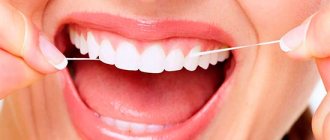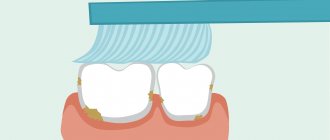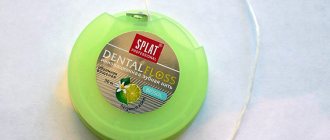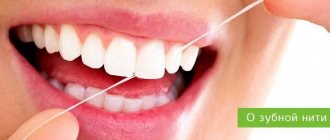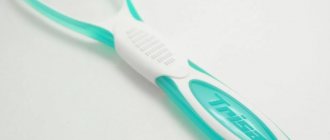Indications Advantages of use Contraindications How to use?
Dental floss and braces Types How to choose? If the floss gets stuck Brand rating For quality oral hygiene, just a brush with paste is not enough. Teeth have 5 surfaces, the brush effectively cleans 3 - anterior, lingual, chewing. The remaining 2 (cervical area, interdental spaces) need to be cleaned of plaque and food debris using additional hygiene products - dental floss or an interdental brush. And if, with dense interdental spaces, the effectiveness of a brush is in doubt, then the benefits of correctly chosen flosses are obvious. But many people don’t even know how to use dental floss correctly.
What is dental floss?
Floss is a special thread made of silk or polymer fiber for high-quality cleaning of the spaces between incisors, canines, premolars, and molars. It helps remove food particles in a similar way to a toothpick, but is much safer and more effective. The fibrous structure of dental floss makes it possible to gently and gently remove deposits from the enamel, preventing bacteria from multiplying and destroying hard tissue. The floss is placed between the teeth, cleaning first one side and then the other side of the dentition. It is important to know how to use dental floss correctly, otherwise the opposite effect will be obtained instead of benefit.
When to use floss
There are different recommendations for how to use dental floss. Some experts believe that it is more effective to apply it before hygienic brushing, while others believe that floss is more effective after brushing with paste. There is no general scientific basis or clinical studies on this issue. The only important thing is the systematic use of dental floss.
Direct indication for flossing:
- crowded teeth;
- installation of approximal fillings;
- periodontal diseases;
- the presence of any non-removable orthodontic (braces), orthopedic (crowns, dentures) structures.
To maintain healthy teeth and gums, hygienic cleaning should be performed 2 times, daily, morning and evening. Flossing is part of oral hygiene. This product will finish the job where you can’t reach with a brush. Dental floss is recommended for everyone, without restrictions on age or structural features of the dental system. Flossing is needed for milk teeth, permanent teeth, and artificial teeth (crowns, dentures).
The essence of the device
Human teeth have five surfaces, and a toothbrush only cleans three of them. The space between the teeth remains unbrushed, this creates a favorable environment for the development of pathogenic microorganisms. Floss penetrates into places that are inaccessible to a toothbrush and provides 100% oral hygiene.
Important! Without flossing, more than 1/3 of the surface of the teeth remains uncleaned, which undoubtedly affects their condition.
It can be made from high quality artificial fibers:
- acetate;
- nylon;
- nylon;
- natural silk.
There are a large number of types of floss, and when choosing, you should pay attention not only to the cost and its manufacturer, but also to what teeth it will need to care for.
- If a person is just learning to brush their teeth with floss, it is recommended to use waxed floss.
- If you already have experience using floss, it is better to choose unwaxed ones - they exfoliate, which allows you to clean a larger area.
- Flat floss is recommended for cleaning narrow spaces between teeth.
- Flosses with a round cross-section are best used for cleaning wide spaces. Thick threads expand when in contact with saliva, and this not only promotes better cleansing, but reduces the risk of gum injury.
- There are ribbon flosses that are recommended to be used for trema or diastema.
The impregnation of dental floss is of no small importance, since this device not only cleans the interdental spaces, but also has a therapeutic or preventive effect. In most cases, manufacturers use sodium fluoride for impregnation - it strengthens tooth enamel and prevents the development of caries. There are threads for breath freshening with menthol, for disinfection - with chlorhexidine, and so on.
Reference! Dental floss is also classified by purpose - some are used only in the dentist's office, while others are suitable for use at home.
Oral-B dental floss :
- Pro-Expert Clinic Line is a lightweight sliding fiber designed for a wide range of consumers.
- Essential Floss - with polymer components that remove plaque.
- Satin Floss – silk.
- Essential Floss – waxed, gently cleans the space between teeth.
Colgate Dental Floss:
- Colgate® Total - impregnated with sodium pyrophosphate, mint flavor.
- Colgate Optic White – has an additive with bactericidal properties.
PresiDENT dental floss:
- SILVER CARE – thin, contains silver nitrate and sodium chloride, has a refreshing mint taste.
- Dental floss with chlorhexidine - recommended for those who have problems with gum inflammation.
- Extra flat floss is a ribbon thread designed for narrow spaces between teeth.
- Multi-active – swells under the influence of saliva.
- Whitening dental floss with papain – contains papaya enzyme, which has whitening properties.
Dental floss Sensodyne Total Care is able to increase in size under the influence of saliva, suitable for sensitive teeth and gums. Lacalut Dental are made of nylon with a round cross-section.
How to use: instructions
To use dental floss most effectively, you need to know the correct cleaning technology:
- Pull out a part of the floss 45-60 cm long. This length is enough to securely fix the thread on your fingers. Also, each dental unit is processed with a new part, so it is more convenient to initially take a longer floss.
- Twist the ends of the thread around your index or middle fingers. Make several turns, leaving a stretched part about 3 cm long between the thumbs. This part will be used to clean the contact surfaces.
- Gently insert the floss into the interdental space. After several light forward movements, the thread is inserted just below the gingival margin. Carefully move it up and down between the contact surfaces, around the tooth, slightly penetrating under the cervical area. Do not tug or pull the thread so as not to damage the mucous membrane and gum tissue.
- A similar procedure is repeated for all adjacent teeth. Cleaning begins with the upper row of teeth, then cleans the lower one. They move from the central incisors to the edges, in one direction or the other. To develop a habit, you should clean the segments according to the same principle each time.
- Moving on to the next tooth, move the floss using a new, clean part. To do this, move your fingers, rewinding the used segment.
- After cleaning, rinse your mouth with warm water or a special product. This will get rid of food particles, plaque residues, and provide fresh breath.
Do not make cutting movements or insert the thread deep under the gum, avoiding damage to the dentogingival attachment. When everything is done correctly, there is no discomfort or pain. After processing the dentition, the used floss is thrown away. Repeated use will provoke the spread of pathogenic microorganisms in the oral cavity, inflammation and other problems.
The first few days after flossing, your gums may bleed slightly. With regular cleaning, the bleeding stops on its own. But if during hygiene you constantly find bleeding gums, you need to go to the dentist for an examination and diagnosis.
At what age are children allowed?
A child can use floss independently no earlier than 10 years old, but you can start getting acquainted with it much earlier. First, parents themselves must clean the interdental spaces in the child’s mouth, and over time teach the child to carry out this procedure independently.
However, some dentists do not recommend using floss before the age of 12, and explain this by the fact that:
- a child’s mucous membrane is very delicate and can be easily injured;
- not all milk teeth have been replaced by permanent ones;
- the child may make sudden movements with the floss, which will cause bleeding gums and inflammation.
Important! The child should carry out the first few independent procedures for flossing his teeth under the supervision of his parents.
How to floss with braces
For braces, there are superflosses with hard tips that clean not only the contact surfaces of the enamel, but also the elements of the corrective equipment. They easily pass areas above/under the arch, around the locks. The floss is inserted over the arch into the interdental space. When the thread is in the correct position, use gentle up and down movements to clean the enamel surfaces. All other adjacent surfaces of the dental units are cleaned in a similar way. The thread is used after cleaning with a brush or brush. A special orthodontic needle threader will make threading over the wire easier.
Kinds
Modern threads are made from silk or polymer fibers (nylon, nylon, Teflon, acetate). Floss is sold in special cassettes (from 10 to 100 m), providing hygienic storage and comfortable unwinding of the required length, thanks to the cutting edge under the lid.
Manufacturers also offer threads on a holder (flosser, dental machine). They are sold in several units per package. Some people choose a flosser, since its use eliminates the contact of hands with the oral mucosa and makes caring for eighth molars (wisdom teeth) easier.
What is the difference between dental floss?
Various types of thread are available for sale. Waxed, non-waxed, impregnated with silver, menthol, medicinal herbal extracts, as indicated on the package. Flosses are distinguished by cross-section, thickness, material, and processing.
According to sectional shape
- Round – recommended for large gaps between teeth;
- flat dental floss – efficiently removes deposits from crowded teeth and dense contact points;
- tape - for trema, diastemas.
By surface treatment
- Waxed - flosses treated with a thin layer of wax glide easily in the interdental space, are safe, suitable for gum disease, do not separate, simplify care;
- not waxed - they separate into fibers during use, the abrasive surface copes better with cleaning.
The difference between waxed and non-waxed dental floss is that the former penetrates between the teeth more easily, while the latter cleans the surface better.
By material
- Nylon - durable, strong, cleans contact surfaces efficiently, which makes them one of the most popular;
- silk dental floss - characterized by low mechanical tensile strength, therefore less and less are produced;
- nylon - reliable, strong, but less flexible than nylon models;
- acetate - elastic, soft, similar in characteristics to silk threads;
- Teflon - have the lowest coefficient of friction, quickly cope with dental plaque, the most expensive of all analogues.
All types of floss provide a similar effect. And the systematic, correct use of dental floss is more important than the brand, model or price.
Impregnations for threads
During the production process, floss manufacturers add various impregnations and flavors to the threads to make the process of brushing teeth more enjoyable and effective. Impregnations can be flavoring, mineralizing and antiseptic:
- Menthol (or fruit) - have a pleasant aroma and freshen your breath.
In addition to menthol, fruit flavors are also used, for example, lemon, cinnamon, strawberry, etc. Curaprox DF834 waxed dental floss has a pleasant mint taste . Thread length 50 m.
Waxed floss Curaprox DF834, 50 m
Waxed thread Splat Dental Floss with strawberries, 30 m
Waxed thread Splat Dental Floss with bergamot and lime, 30 m
Waxed thread Splat Dental Floss with coconut, 40 m
- Fluoride - provide additional strengthening of teeth due to the mineralization of enamel with fluoride ions.
These flosses are recommended for those who have sensitive teeth. Pierrot Dental floss with aloe vera from the Spanish company Fushima is made of nylon . It contains fluoride and aloe vera juice for anti-inflammatory effects. Thread length 50 m.
Waxed dental floss Pierrot Dental floss EXPANDING, 30 m
Waxed dental floss Pierrot Dental floss with aloe vera, 50 m
Waxed dental floss Pierrot Dental Floss with strawberries, 50 m
- Chlorhexidine - have an additional antiseptic effect, reducing the likelihood of developing inflammatory gum diseases.
When choosing a thread with chlorhexidine, we recommend paying attention to the high-quality tape thread Mirafloss chx-Tape. The thread is unwaxed. Length 20 m.
Tape floss with chlorhexidine miradent Mirafloss chx-Tape, 20 m
Floss Curaprox PTFE floss tape DF820 with chlorhexidine, 35 m
Some threads contain combinations of several of the impregnations described above, and some are made without any impregnations.
How to choose
There are several main parameters by which dental floss is chosen. The first is size. The wider the interdental space, the larger the diameter of the floss needed. The second thing people pay attention to is the material, or rather the surface treatment. For beginners, it is better to choose a waxed thread, as it does not delaminate, easily enters the interdental space, and makes care easier. But floss without waxing removes deposits from hard-to-reach places better. People with braces and dentures should choose special models (superflosses), which do an excellent job of both cleaning between teeth and caring for elements of the orthodontic or orthopedic system.
Many patients are interested in what can replace dental floss. A good alternative is a flosser; it’s easy to use, you don’t need to monitor the length of the thread, and it’s easier to care for the outer teeth in a row. The irrigator does a better job of cleaning the periodontal sulcus, pathological pockets, and performs hydromassage of the gums, but it is not capable of cleaning the interdental spaces as efficiently as floss.
What to do if the floss gets stuck
If dental floss gets stuck between teeth, you need to determine the cause. This happens if the size is incorrectly selected, if there are cracks, chips on the contact surface of the enamel or caries in this area. Another reason is tartar between the teeth, on which the floss clings, breaks, and as a result gets stuck.
To remove a stuck thread:
- rinse your mouth vigorously with water;
- rinse the interdental space with an irrigator;
- use a new thread to remove the problematic piece;
- use tweezers.
If these methods do not help, you should consult a doctor. Do not use needles, toothpicks, fishing lines, tines of forks or other sharp objects. This could result in serious injury. The dentist will remove the stuck piece quickly, without problems, using special tools.
Contraindications to the use of threads
Dentists prohibit the use of floss during inflammatory processes on the oral mucosa. Active periodontal disease, gingivitis and stomatitis require preliminary therapy. Only after healing can the doctor allow flossing.
The main damage is caused by incorrect application technique. Aggressive movements can injure the gums, cheeks, and tongue. An infection can get into the wounds, causing inflammation and bleeding. Permanent injury can lead to tooth loss. Therefore, if in doubt or after unsuccessful attempts to use floss, you should contact your dentist for help.
